Public Health, Arts, Parks and Recreation Revised 11/21
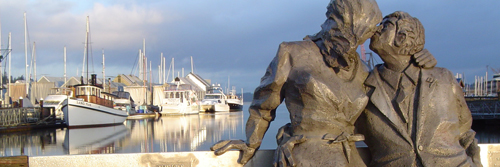
Extraordinary parks, arts and recreation provide opportunities for meaningful life experiences.
What Olympia Values:
Olympians value the role parks, open space, recreation and art play in our lives; as these contribute to our sense of community, and to our physical, spiritual and emotional well-being.
Our Vision for the Future:
A healthy, fun and enriching place to live.
Read more in the Community Values and Vision chapter
Introduction
Olympia’s great parks, vibrant arts community, and many recreation and enrichment programs enrich our lives and strengthen our connection to the community. Public gathering places, whether a small pocket park or large playfield satisfy our need to join with others in the community. One only has to walk to a neighborhood park, search for a new skill to learn, or catch the latest downtown Arts Walk to experience this. The City, community groups, volunteers, and businesses all play a vital role in shaping parks, arts, and recreation. These facilities and programs improve people’s quality of life, promote active lifestyles, create a sense of place and contribute to the local economy. The City of Olympia takes an active role, when appropriate, in influencing regional health policy where it relates to Olympians.
Parks, Arts and Recreation Programs and Facilities
Parks and recreation programs support healthy lives, and those healthy individuals and families help sustain a healthy community. City programs offer opportunities to exercise and reduce stress, as well as support personal growth and emotional well-being.
Some recreational amenities are regional in nature and a regional approach to their implementation can be effective. As it developed this plan, the City looked at opportunities for coordinating with other local and regional governments to develop more parks and recreational facilities. For example, community parks lend themselves to a regional approach, particularly if a potential site is located near a border with Lacey, Tumwater, or Thurston County. Other regional efforts could include an Art Center, a regional trail network, recreational programming, or even an ice skating rink or swimming pool. The City will continue to explore these opportunities.
The following goals and policies apply to all parks, arts and recreation programs, and facilities.
Unique facilities, public art, events, and recreational programming encourage social interaction, foster community building, and enhance the visual character and livability of Olympia.
PR1.1Continue to provide extraordinary parks and community programs that contribute to our high quality of life and attract tourism and private investment to Olympia.
PR1.2Promote City parks, arts, and recreation programs and facilities so they are used and enjoyed by as many community members as possible.
PR1.3Be responsive to emerging needs for programs, facilities, and community events.
PR2.1Seek non-profit organization and community member partnerships, sponsorships, grants, and private donations for park and facility acquisition, development, operation, programming, and events.
PR2.2Use creative problem-solving and cost-effective approaches to development, operations, and programming.
PR2.3Continue the Joint Use Agreement between the City and the Olympia School District to provide recreation facilities and programming for the community.
PR2.4Seek opportunities to increase revenues generated by users of park facilities and concessions.
PR2.5Search for opportunities for mixed-use facilities and public/private partnerships.
Parks
There are 52 parks and open spaces in the City of Olympia that give us a variety of opportunities to enjoy the outdoors from hiking in Watershed Park, to keeping cool in the Heritage Park Fountain, to strolling along Percival Landing, to getting married in the Rose Garden at Priest Point Park. Despite the number of parks we have, however, there are still unmet needs, such as soccer fields, dog parks, community gardens, bike and nature trails, and open space. For a complete inventory of all existing park, recreation and open space lands in Olympia see the Parks, Arts and Recreation Plan.
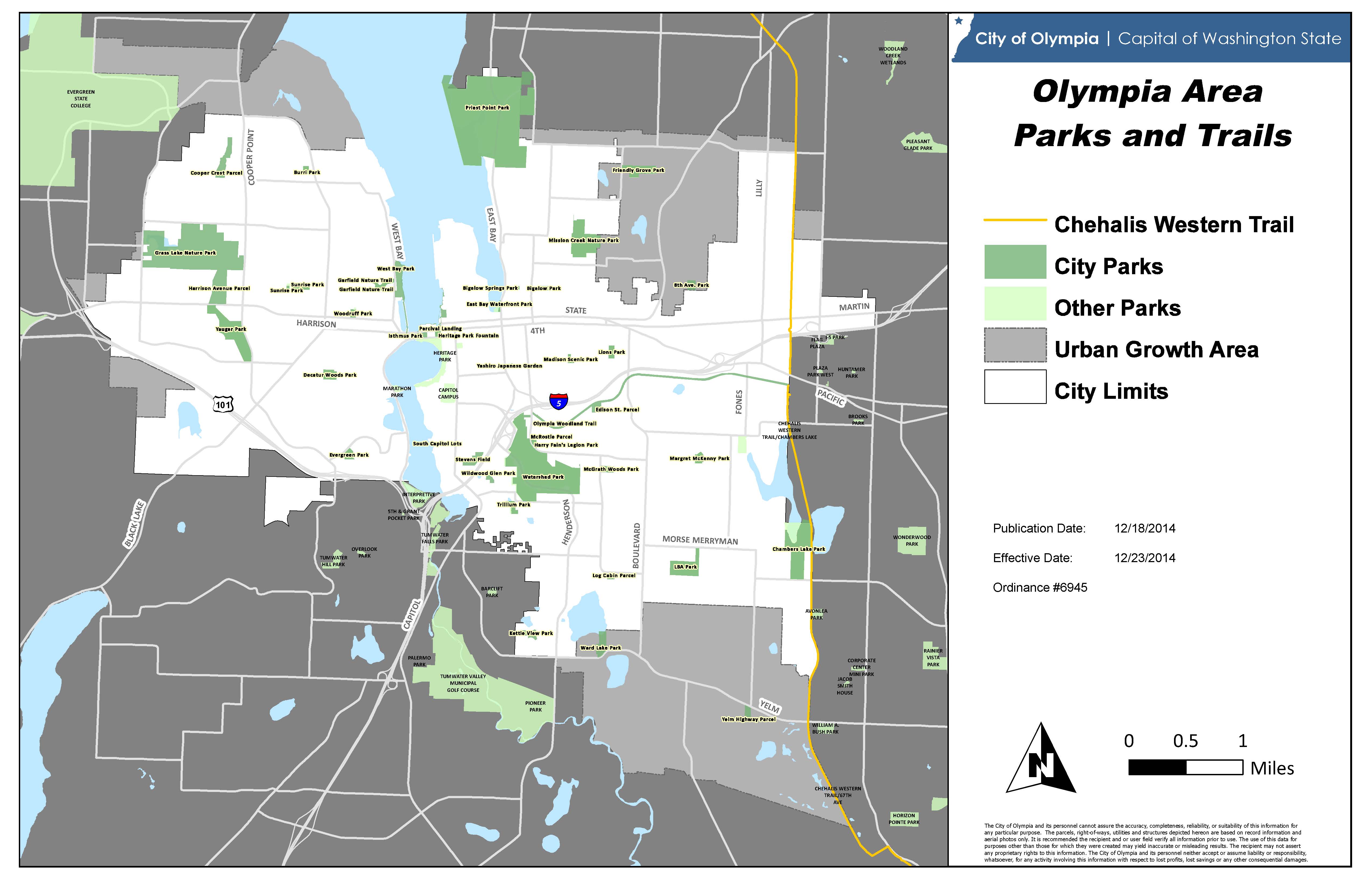
Over the next 20 years, Olympia will face a number of challenges as it works to meet the demand for parks and open space:
• Funding for Large Capital Projects. Current funding is not adequate to complete the Percival Landing project and the Isthmus gateway, acquire and develop a 40-acre community park, and complete the West Bay Park and Trail. These are all multi-million dollar projects.
• Acquiring Land for New Parks. As our population increases we will need more parks and open space to maintain the same level of service standards yet less land and fewer large parcels will be available.
• Maintaining an Aging Infrastructure. As Olympia’s park infrastructure ages, it becomes more important, and more expensive, to maintain.
Maintaining the quality of Olympia’s parks and recreation system
Level of Service Standards
The Parks and Recreation Plan:
Every six years, the City undertakes an extensive public outreach effort to update its Parks, Arts and Recreation Plan. During this time, community members have an opportunity to share what they want from our park system, and our arts and recreation needs, which are used to update Olympia’s park level of service standards. These standards -- the ratio of developed park land per 1,000 residents --- are used to evaluate the need to acquire more park land or build more recreation facilities.
The Capital Facilities Plan:
The Capital Facilities Plan describes how the City finances new park acquisition and development, which is funded by a variety of sources including the two percent private utility tax, park impact fees, Washington’s State Environmental Policy Act (SEPA) mitigation fees, grants and donations. While most of the park projects proposed in the Parks, Arts and Recreation Plan already have identified funding sources, some do not.
Neighborhood Parks
A Neighborhood Park is usually a small playground and open area designed primarily for non-supervised, non-organized recreational activities. A typical Neighborhood Park might include a children’s playground, a picnic shelter, a restroom, and open grass areas for passive and active use. These parks also may include trails, tennis courts, basketball courts, skate courts, public art, and community gardens. Since each Neighborhood Park is unique, residents will often travel throughout the City to experience a variety of them. The service area for Neighborhood Parks is thus the entire City and its Urban Growth Area.
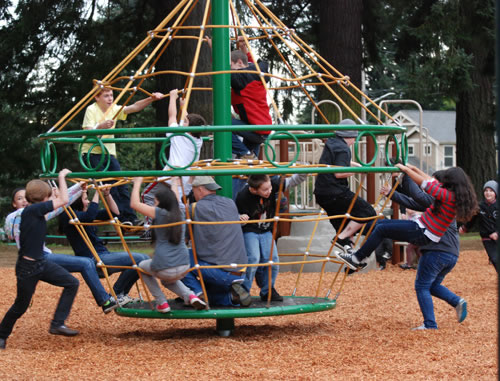
Neighborhood parks such as Lion’s Park provide nearby places to be active.
There are currently 26 Neighborhood Parks in Olympia totaling 72 acres. As Olympia’s population grows, some of our Neighborhood Parks are nearing capacity. To address this, the City estimates that it needs to acquire ten additional Neighborhood Park sites totaling approximately 20 acres within 20 years. This is also consistent with the goal expressed in the Parks, Arts and Recreation Plan of having a neighborhood park within walking distance to most residences.
For more information on the Neighborhood Park standard see the Parks, Arts and Recreation Plan.
Community Parks
Community Parks are designed to serve the larger community, and are either athletic fields or sites that have a special focus.
Athletic field space can range from a single field at a park to a multiple-field complex. Large athletic field complexes are the most cost-effective for efficient scheduling and maintenance. Though they are designed for organized activities and sports, individual and family activities are also encouraged. Athletic field complexes bring large groups together and require more facilities, such as parking, restrooms and picnic shelters. Olympia’s three existing athletic field complexes are: LBA Park, Yauger Park and Stevens Field. Combined, these parks total 75 acres.
Other Community Parks may have a special focus, such as a waterfront, garden, or water feature. Some examples include the Heritage Park Fountain, Yashiro Japanese Garden, and Percival Landing.
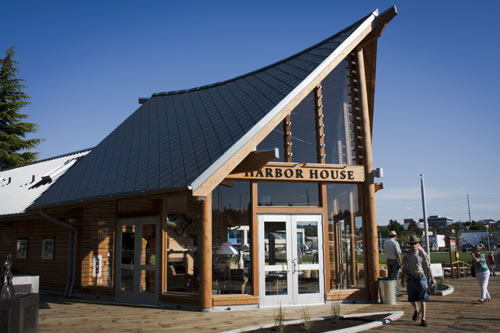
Community parks add to Olympia’s vitality (Percival Landing).
Olympia provides athletic fields through a combination of City parks and school fields. But there still is a need for additional rectangular fields. In recent years, soccer groups have been turned away and have used fields available in other jurisdictions. Some athletic fields have been so over-used that they cannot recover for the following season, which is leading to long-term deterioration. While the City will continue its efforts to acquire large parcels for future athletic field complexes, it recognizes that with very few large undeveloped parcels available, it may be necessary to meet the future athletic field need with single fields at multiple parks.
Community Parks also can have special features such as off-leash dog areas, bicycle courses, freshwater swim beaches, waterfront access and community gardens. Based on community needs, Olympia will also need to add additional Community Park acreage to provide for these desired recreational amenities.
For organized sports, it matters less where the player lives, but rather where a game is scheduled. Much like a transit system or library system that is “area-wide”, Community Parks serve the entire Olympia urban growth area. Thus the service area for Community Parks is defined as being all of Olympia and all of Olympia’s urban growth area.
The City estimates that it needs to acquire an additional 84 acres of community parks to meet the demand for Community Parks within 20 years. For more information on the Community Park standard see the Parks, Arts and Recreation Plan.
Open Space
Open Space is defined as primarily undeveloped land set aside for community members to enjoy nature and to protect the natural character of Olympia’s landscape. It may include trails; wetlands; wetland buffers; stream or river corridors and aquatic habitat; forested or upland wildlife areas; ravines, bluffs, or other geologically hazardous areas; prairies/meadows; and undeveloped areas within existing parks. Trail development to allow passive recreation such as nature observation and hiking is encouraged in these areas, except in cases where wildlife conservation is the primary function. Parking and trailhead facilities such as restrooms, information kiosks and environmental education facilities are also appropriate.
(Note that the term "Open Space" as used in this chapter has a more specific meaning than as used in the Natural Environment Chapter pursuant to RCW 36.70A.160).
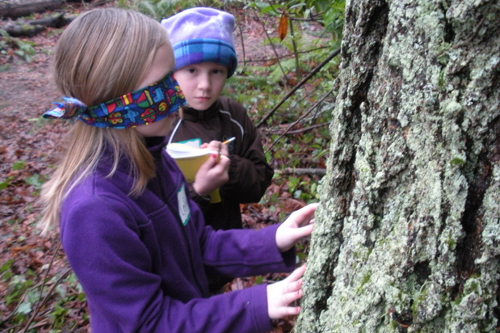
Open spaces such as Mission Creek Nature Park provide opportunities to experience nature within the city.
Research has shown that residents are willing to travel across town looking for the special and unique features associated with one Open Space in particular. For instance, Watershed Park provides walking trails in a stream and wetland complex while Priest Point Park provides saltwater beach access and old growth forests. Much like a transit system or library system that is “area-wide”, Open Spaces serve the entire Olympia urban growth area. Thus the service area for Open Space is defined as being all of Olympia and all of Olympia’s urban growth area.
Open Space has a very high value to Olympia residents. In a series of neighborhood workshops conducted for a recent update to the Parks, Arts and Recreation Plan, one of the most dominant themes was “Buy open space/natural areas – provide nearby access to nature.”
313 acres of Open Space acquisition are proposed for the next 20 years. These acquisitions will meet the Open Space Level of Service Standard and will address the impact of projected population growth on the Open Space system. For more information on the Open Space standard see the Parks, Arts and Recreation Plan.
The level of service standards outlined above and the following goals and policies will guide Olympia’s park system towards achieving its vision over the next 20 years.
Goals and Policies
PR3.1Provide parks in close proximity to all residents.
PR3.2Ensure that Olympia’s park system includes opportunities for community members to experience nature and solitude as a healthy escape from the fast pace of urban life.
PR3.3Preserve and enhance scenic views and significant historic sites within Olympia’s park system.
PR3.4Identify and acquire future park and open space sites in the Urban Growth Area.
PR3.5Beautify entry corridors to our City and our neighborhoods, giving priority to street beautification downtown and along Urban Corridors.
PR3.6Continue to collect park impact fees within the Olympia City Limits and SEPA-based mitigation fees in the Olympia Urban Growth Areas so new development pays its fair share to the park and open space system based on its proportionate share of impact. Work with Thurston County to devise an alternative system for funding parks and open space in the unincorporated Urban Growth Area.
PR3.7During development review, if consistent with park level of service standards or other needs, encourage developers to dedicate land for future parks, open space, and recreation facilities.
PR3.8Develop parks or plazas near Urban Corridors.
An urban trails system interconnects parks, schools, neighborhoods, open spaces, historical settings, neighboring jurisdictions’ trails systems, important public facilities, and employment centers via both on- and off-street trails.
PR4.1Coordinate with adjacent jurisdictions and State agencies to build a regional trail network and coordinated trail signage program that is consistent with the Thurston Regional Trails Plan.
PR4.2Use existing rail, utility, and unopened street rights-of-way, alleys, streams (where environmentally sound), and other corridors for urban trails.
PR4.3Preserve unimproved public rights-of-way for important open space, greenway linkages, and trails.
PR4.4Encourage walking and bicycling for recreation and transportation purposes by linking parks to walking routes, streets and trails.
PR4.5When located in areas where future trails are shown on the adopted map, ensure that new development provides appropriate pieces of the trail system using impact fees, the SEPA process, trail Right-of-Way dedication, or other means.
PR5.1Complete Percival Landing reconstruction and West Bay Park construction.
PR5.2Encourage creation of a public shoreline trail as property north of West Bay Park is developed.
PR5.3Develop a West Bay trail alignment that follows the shoreline and connects to Deschutes Parkway to the south.
PR5.4Designate waterfront trails and important waterfront destinations as the "Olympia Waterfront Route" as outlined in the Thurston Regional Trails Plan.
PR5.5Encourage the acquisition of saltwater shoreline property and easements to create more public access to the waterfront.
PR5.6Preserve street rights-of-way when they extend to shorelands and install signs that indicate public access.
PR6.1Continue to implement and refine the City-wide Asset Management Program to make sure the City’s public facilities remain functional and safe for as long as they were designed for.
PR6.2Establish a dedicated and sustainable funding source for maintaining City parks, landscape medians, roundabouts, entry corridors, street trees, City buildings, and other landscaped areas in street rights-of-way.
PR6.3Protect the City’s investment from damage by vandalism, encampments, and other misuse in a manner that preserves the intended purpose.
PR6.4Consider regional approaches to funding major recreational facilities, such as swimming pools, regional trails, art centers, and tournament-level athletic fields.
PR6.5Establish a strategy for funding maintenance and operation of new park facilities before they are developed.
Arts
Olympia is now home to approximately 2,500 individual artists and almost 100 arts organizations and venues. Our resident artists are musicians, writers, actors, and visual artists who are both nationally known and emerging. Olympia hosts award-winning theater, ground breaking music performances, the Procession of the Species, and a strong visual arts community that ranges from informal artists to those with nationwide gallery representation.
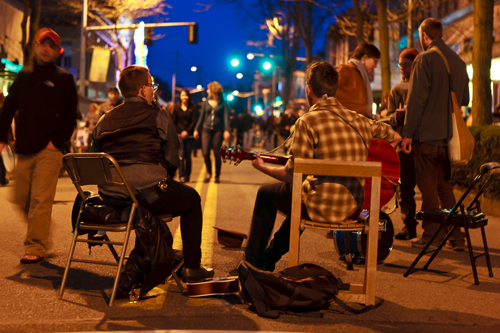
Arts Walk is one of the largest public events in the community and a source of civic spirit and pride.
Over the next 20 years, Olympia will face two challenges:
• Creating an Arts Center. In 1989, the City first identified a need for a regional arts center with exhibition space, working studios, and rehearsal space for regional artists.
• Retaining Artists. Social and economic factors such as cost of living, affordable housing, and stable economy may make it harder for Olympia to retain its artists.
Goals and Policies
Permanent and temporary public art is located in parks, sidewalks, roundabouts, public buildings, alleys and other public spaces.
PR7.1Include diverse works of art.
PR7.2Ensure opportunities and participation by local, regional and national artists.
PR7.3Use public art to create unique community places and visible landmarks.
PR7.4Incorporate art into public spaces such as sidewalks, bridges, parking meters, tree grates, buildings, benches, bike racks and transit stops.
PR7.5Encourage community participation at all levels of the public art process.
PR7.6Ensure our public art collection is regularly maintained so it retains its beauty and value.
PR7.7Encourage art in vacant storefronts.
PR7.8Encourage neighborhood art studios.
PR7.9Support art installations that produce solar or wind generated energy.
PR7.10Help artists, organizations and businesses identify possible locations in commercial areas for studios and exhibition space.
PR7.11Establish an "art in city buildings" program that would host rotating art exhibits.
PR8.1Pursue a regional community arts center.
PR8.2Pursue affordable housing and studio/rehearsal space for artists, including support for, or participation in, establishing or constructing buildings or sections of buildings that provide living, work and gallery space exclusively for artists.
PR8.3Encourage broad arts participation in the community.
PR8.4Provide opportunities for the public to learn about and engage in the art-making process.
PR8.5Provide opportunities that highlight the talent of visual, literary and performing artists.
PR8.6Provide technical support to art organizations.
PR8.7Establish and promote a theater and entertainment district in downtown Olympia.
PR8.8Create a range of opportunities for the public to interact with art; from s mall workshops to large community events.
PR8.9Encourage early arts education opportunities.
Recreation
The City’s recreation programs promote physical and mental well-being, bring community members together in a positive, supportive, and fun atmosphere, and create memorable experiences for individuals and families. The City offers traditional programs such as sports leagues, youth camps and clinics, and special interest classes. It also responds to emerging recreational interests, such as the Ultimate Frisbee league, high-energy dance classes, and community gardens. Each year, approximately 400 teams participate in City sports leagues, more than 4,000 community members take a leisure recreation class, and more than 1,500 youth participate in camp programs. In addition to enhancing participants’ wellness, people who participate in these programs also gain a sense of belonging to the community.
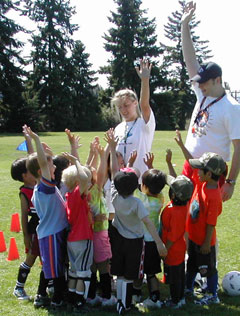
Recreation Programs foster community health and wellness ("Kids Love Soccer" Program).
Olympia’s recreation programs face the following challenges:
• Activating our Community. Our sedentary lifestyles are contributing to health problems. The City must find places and programs that can compete with the ease and simplicity of TV and computers for our time and attention
• Connecting with Nature. Our electronic toys and indoor jobs have created a culture less connected to nature. If our residents are not connected to nature it will become increasingly difficult for them to understand or embrace environmental stewardship
• An aging population that’s ready for action: Between 2010 and 2030, Olympia’s senior population is projected to double. But the seniors of the future are likely to be more active and adventurous than in prior generations. Olympia’s recreation programs need to embrace this trend.
Goals and Policies
PR9.1Provide opportunities that promote a mentally and physically active lifestyle and healthy food choices, including participation in local food production.
PR9.2Provide programs and facilities that stimulate creative and competitive play for all ages.
PR9.3Provide programs, facilities, and community events that support diverse self-expression.
PR9.4Provide opportunities for bringing balance, relaxation, and lifelong learning into one’s life.
PR10.1Enhance recreation opportunities for the Olympia area’s physically and mentally disabled populations.
PR10.2Provide recreational opportunities for all family structures.
PR10.3Work towards providing recreation programs that are affordable and available to all community members.
PR10.4Provide parks and programs to serve people of all ages, and with many different abilities, and interests.
PR10.5Develop programs and design park facilities that encourage activities people can do together regardless of their age.
PR10.6Provide convenient, safe, active, outdoor recreation experiences suited for families.
For More Information
• Parks, Arts and Recreation Plan
• Olympia’s Capital Facilities Plan shows how park projects will be funded during a six year period
• For a complete list of all of Olympia’s parks and trails, see Parks and Trails
• For a comprehensive look at regional trail planning, see the Thurston Regional Trails Plan
• Information on the City’s Public Art Collection can be found at Public Art
• In 2007, the Art’s Commission participated in an Arts Center Feasibility Study
• To learn more about the City of Olympia’s recreational programs and classes, see Recreation


